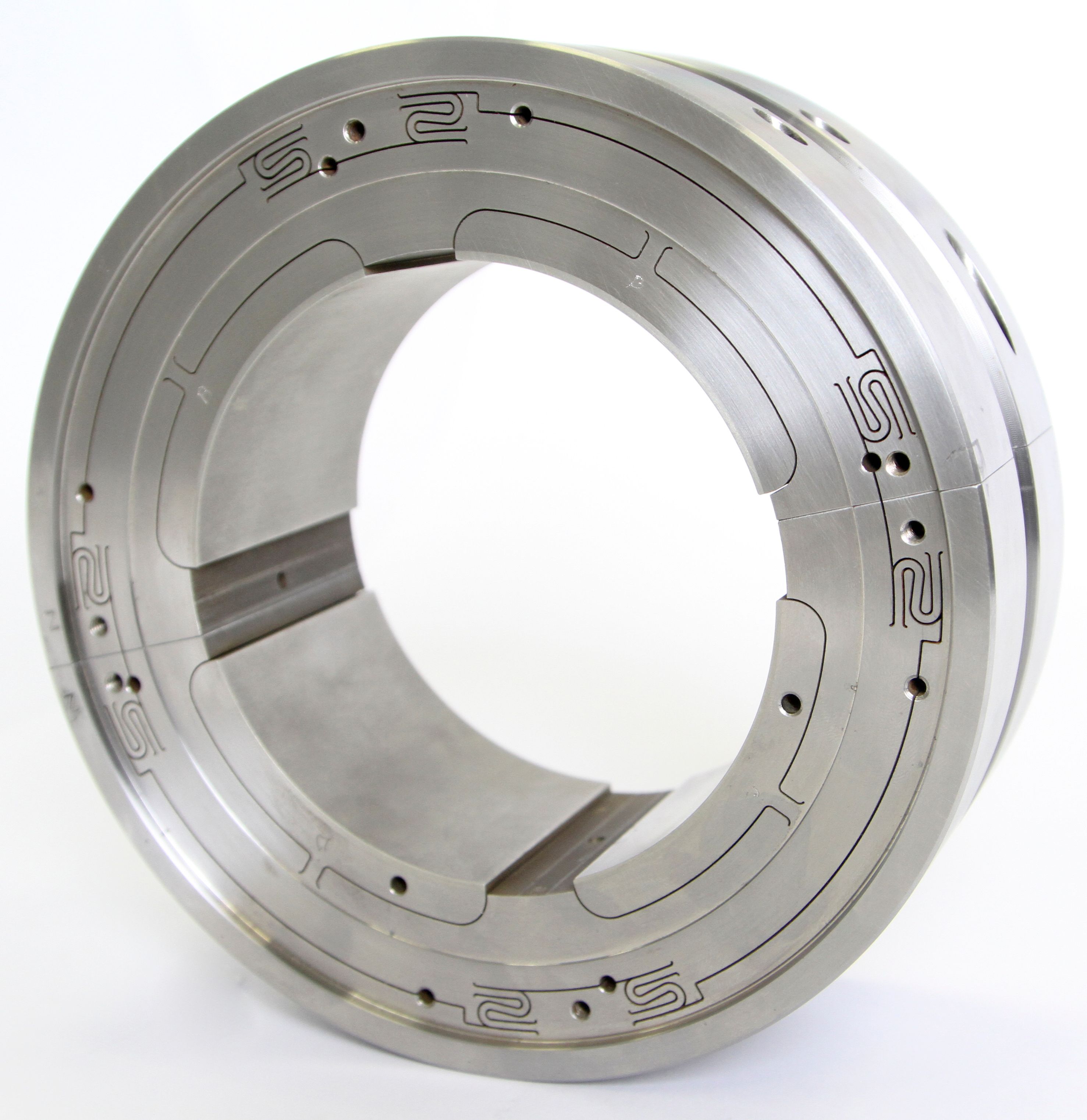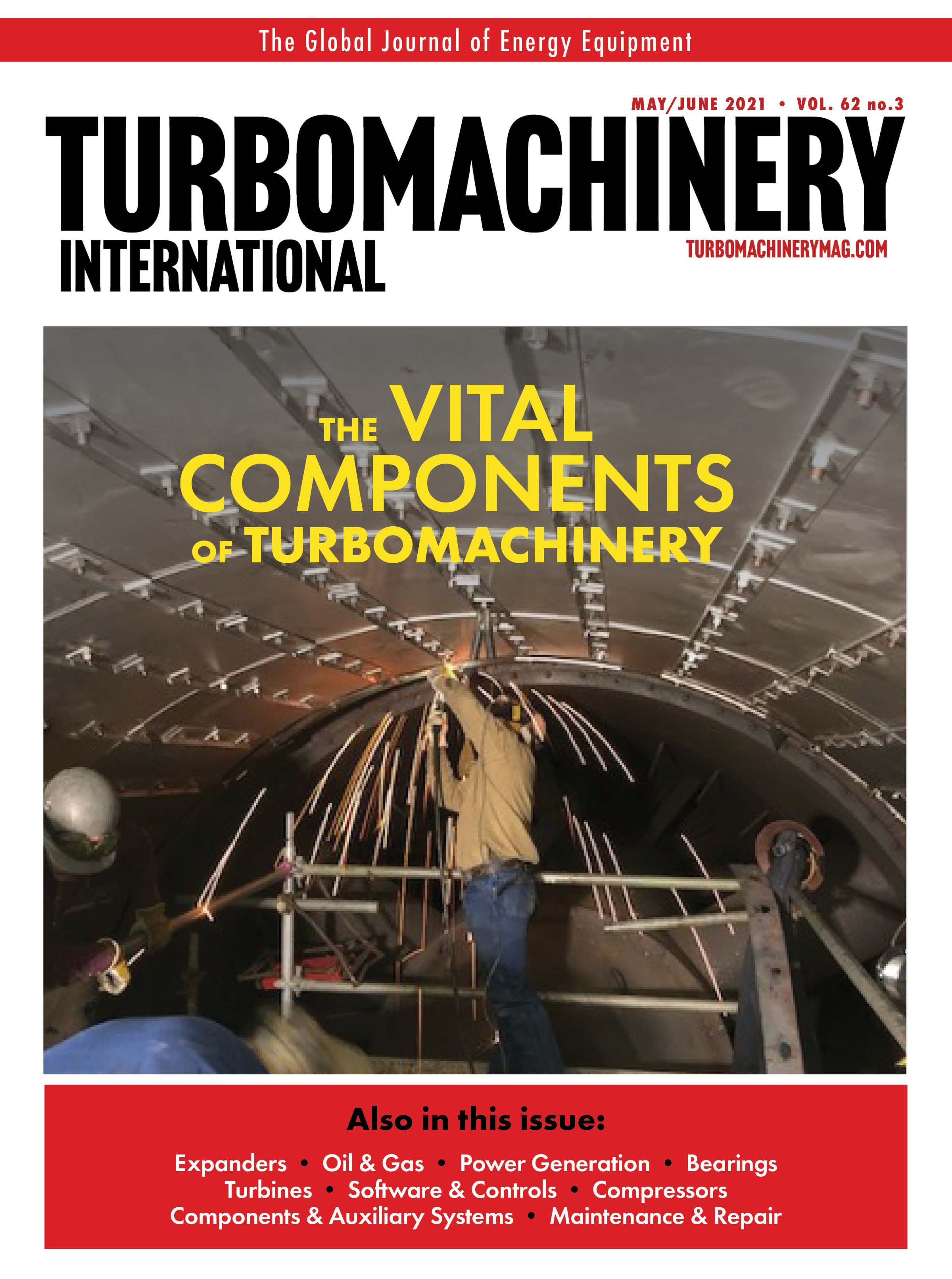Bearings and stability
New squeeze film damper bearings solve rotor stability problems
Waukesha Bearings ISFD Flexure Pivot Bearing

By Hurl Elliott and Heinz Bloch
Although not as common today as in the past, problems can still occur whenever one or more of the following shortcuts are taken:
1. Buying new machines and not doing either a stability verification test or an ASME PTC-10 type 1 test because of (unwise) project cost constraints
2. Not following the proper guidelines outlined in API 617 and API 684 during design audits for new or rerate compressor trains
3. End-user dispensing with design audit validation due to (unwise) project budget constraints.
In 2002, the American Petroleum Institute (API) 684 issued experience-backed guidelines for designing rotor-bearing systems. With their implementation by both compressor users and manufacturers, rotor-bearing stability problem incidents became less prevalent than in the past. However, when stability issues do arise, they can become one of the most damaging problem causes. The consequential damage to critically important machines is often quite extreme; extended downtime in operating plants can be the result.
In view of this, and to thoroughly address the potential issues, turbomachinery manufacturers have invested in modern computer tools. The actions taken by competent manufacturers are fully aligned with up-to-date versions of the relevant guidelines found in API 684. The most widely used approach to mitigate rotor-bearing stability problem is to install a squeeze film damper (SFD) bearing.
A typical SFD with O-ring components that perform three functions:
1. They act as oil seals
2. They provide a centering element for the bearing shell
3. They give needed stiffness to the bearing assembly.
SFD bearings are frequently adopted as the main solution to rotor bearing instability; they are sometimes favored by compressor manufacturers and end users. However, lack of longevity of O-rings can reduce reliability (the life expectancy of an elastomeric O-ring in SFDs is approximately 4 or 5 years). These O-rings function as a centering component for the bearing shell, carrying the full weight of the rotor-bearing assembly. If the rotor is relatively light, the O-ring will remain flexible. However, heavier rotors will cause the O-rings to develop a set (permanent deformation) over time; this elastomeric component will, therefore, lose some of its mechanical properties.
ARC SPRING DAMPERS
An ARC spring damper proved to minimize the shortcoming of O-rings. Fitting the SFD with an ARC spring damper can extend run lengths and solve rotor-bearing stability problems. The high-pressure casing of a three-casing compressor train was replaced to increase plant throughput and accommodate new process conditions. Major changes included a power increase from 16,500 kW to 27,000 kW, and a molecular weight change from 16.4 to 26.8. The new casing had similar construction features to the old casing; identical oil seals, 5-pad (tilting pad) radial bearings, and a balance piston/center labyrinth seal with a bypass (shunt). The machine was designed with the back-to-back impeller arrangement.
The new compressor casing underwent high speed balancing and an API 617 mechanical run test without any observed vibration problems. The OEM had performed a lateral stability analysis during the design phase and no problems were found. The stability analysis was done just prior to release of the API 617 rotor stability guidelines (available since late 2002). That meant that API 617 guidelines were not followed in this instance. Also, because of (risk-inducing) project budget constraints, no PTC-10 performance test was done.
During startup of the plant, the compressor train surged and initiated uncontrollable instability of the high-pressure casing rotor, which resulted in a wreck. Following the wreck, vibration data showed a predominant sub-synchronous vibration at approximately 0.5 x running speed.
Upon shutdown and disassembly of the compressor, all bearings and seals were found damaged. The vibration excursion had exceeded internal clearances, reaching as high as 300 microns. The machine was rebuilt with the spare rotor, bearings and seals, but without further in-depth vibration analysis. The entire train was restarted with new operating procedures intended to prevent surge. The compressor was again severely damaged during startup. Analysis was required to discover underlying causes and implement lasting solutions.
Engineers from the OEM and the plant formed a team and performed a rotor-bearing stability analysis using rotordynamic software to determine the rotor’s response to prevailing destabilizing forces. Conclusion: the compressor was sensitive to destabilizing forces.
Since the journal bearings were already optimized for stability, the investigating team looked at other potential sources for the destabilizing forces. This included oil seals, impeller eye seals, and the balance piston labyrinth (or rotor center) seal.
Software analysis performed by BRG Machinery Consulting found destabilizing forces to be relatively small; The rotor-bearing system needed more damping, and the SFD bearing solution was the quickest available. An SFD bearing was designed, tested and tuned to the rotorbearing system. O-rings helped keep the bearing cage centered. The machine started up successfully with the SFD bearing installed. There were no vibration problems, and the machine survived several subsequent surge events without any signs of instability.
Although the SFD bearing proved successful, plant engineers pointed out that the O-rings would degrade over time due to the load imposed by the weight of the rotor bearing assembly. A plan was put in place to improve the longevity of the SFD: installing an ARC spring damper inside each bearing to support and center the SFD.
The ARC spring damper bearings was designed by the compressor manufacturer to eliminate the load-bearing feature on the O-rings, thus improving reliability. The basic SFD oil film design was retained. The ARC spring damper was made to be soft enough to allow motion, yet strong enough to center the bearing cage. The ARC spring was also sufficiently robust to avoid fatigue failure.
OEM testing confirmed the validity of this design. Further, a design audit study confirmed the stability of the rotor-bearing system as compared to the existing system. The auditors concluded that the overall reliability of the machine would be increased, since the new stability margin exceeded the stability threshold of 20,000 lb./in exceeded the existing threshold by a factor of 2 whereas it had been 1.5 in the existing SFD design.
Achieving long-term reliable operation by combining the traditional SFD and ARC spring does come with a minor disadvantage. The overall stiffness of the combined centering support increased because the stiffness of the ARC spring adds stiffness to that pre-existing in the O-rings. This combined centering stiffness is therefore higher than that of the O-rings alone; the combination reduces the effective damping of the squeeze film and causes the logarithmic decrement to undergo the directional decrease.
After installing the ARC spring along with the SFD bearing, the machine ran for many years well beyond the normally scheduled turnaround intervals. As it did so without any instability problems, the next logical iteration would be a fully integrated, laser-machined one-piece design.
An integral squeeze film damper design eliminates the shortcomings of the typical SFD while combining the capabilities of the ARC spring in one integrated bearing. It incorporates SFD and flexure-pivot tilt pad technologies without using O-rings for centering or stiffening of the bearing shell. Damping and stiffness of the bearing are determined by the design of S-type springs within the bearing shell. Specific damper radial clearances are obtained in the shell by using electrical discharge machining (EDM) or laser-based machining technologies.
REFERENCE: Elliott, H. G. and Bloch, H. P. (2021) “Compressor Technology Advances: 2020 and Beyond.” DeGruyter Publishing, Berlin, Germany.
Authors:
Heinz P. Bloch retired from a position as Exxon Chemicals’ Regional Machinery Engineer for the United States. He is the author of dozens of books on process machinery reliability improvements and maintenance cost reductions. For more information, heinzpbloch@gmail.com
Hurl Elliott is a private consultant for Global Turbomachinery Solutions LLC. He is a former staff rotating engineer for ExxonMobil, and can be reached at hurlge5@gmail.com
Contact the authors for more details on the software analysis and testing results.
For more information on integral squeeze film damper (ISFD) bearings with flexure-pivot tilt pads, contact Waukesha Bearings waukbearing.com


.png&w=3840&q=75)

.png&w=3840&q=75)



.png&w=3840&q=75)



.png&w=3840&q=75)




















